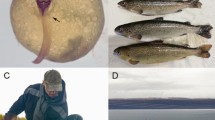Abstract
Sex induction is environmentally stimulated in Daphnia and involves a cue-dependent response for sex determination. Somatic growth was shown to be similar in males and females during juvenile instars, but divergent due to a reduction in male somatic growth, at about the time that females produce ovaries. At this time, males appeared morphologically adult with respect to secondary sex characteristics. Intersex was rare and is unlikely to be important in natural populations. Intersex could be induced in both sexes, and observed more frequently after longer exposure to high temperature, or in the second generation following a temperature change. This indicates an impact on the ability of mothers to determine the sex of the offspring. It may be possible to use intersex characteristics for manipulative investigation of sex-determination mechanisms in Daphnia. Although sex-determination is initiated before birth, intersex occurrence suggests that development of male characters requires an additional process, probably involving hormone activity, during juvenile development and maturation.
Similar content being viewed by others
References
Baer, K. N. & K. D. Owens, 1999. Evaluation of selected endocrine disrupting compounds on sex determination in Daphnia magna using reduced photoperiod and different feeding rates. Bull. envir. Contam. Toxicol. 62: 214–221.
Banta, A. M., 1925. The relation between previous sexual reproduction and the production of male offspring in Moina. Am. Nat. 59: 50–61.
Banta, A. M., 1939. Studies on the Physiology, Genetics and Evolution of Some Cladocera. Publication 513, Carnegie Department of Genetics, Paper 39. Institute of Washington, Washington, DC. pp.
Ebert, D., 1994. A maturation size threshold and phenotypic plasticity of age and size at maturity in Daphnia magna. Oikos 69: 309–317.
Edmondson, W. T.& A. H. Litt. 1982. Daphnia in Lake Washington. Limnol. Oceanogr. 27: 272–293.
Hasegawa, Y., E. Hirose & Y. Katakura, 1993. Hormonal control of sexual differentiation and reproduction in Crustacea. Am. Zool. 33: 403–411.
Hebert, P. D. N., 1978. The population biology of Daphnia. Biol. Rev. 53: 387–426.
Hebert, P. D. N., 1987. Genetics of Daphnia. Mem. Ist. ital. Idrobiol. 45: 439–460.
Hobaek, A. & P. Larsson, 1990. Sex determination in Daphnia magna. Ecology 71: 2255–2268.
Mitchell, S. E. & W. Lampert, 2000. Temperature adaptation in a geographically widespread zooplankter, Daphnia magna. J. evol. Biol. 13: 371–382.
Sanford, K. K., 1947, The effect of temperature on the intersex character of Daphnia longispina. Physiol. Zool. 20: 325–332.
Zaffagnini, F., 1987. Reproduction in Daphnia. Mem. Ist. ital. Idrobiol. 45: 245–284.
Zou, E. & M. Fingerman., 1997. Synthetic estrogenic agents do not interfere with sex differentiation but do inhibit molting of the Cladoceran Daphnia magna. Bull. envir. Contam. Toxicol. 58: 596–602.
Author information
Authors and Affiliations
Rights and permissions
About this article
Cite this article
Mitchell, S.E. Intersex and male development in Daphnia magna. Hydrobiologia 442, 145–156 (2001). https://doi.org/10.1023/A:1017564105942
Issue Date:
DOI: https://doi.org/10.1023/A:1017564105942




